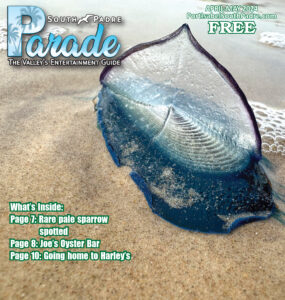By M. Kathy Raines
Special to the PARADE
The sloping forehead of this multi-dimensional fish ends in a tiny, puckered “o” of perpetual awe or surprise.
This is silly, of course. All fish wear fixed facial “expressions”, so to speak. Still, given our propensity to personify our fellow creatures, scrawled cowfish look, well, adorable. Even Gladys Porter Zoo aquarists Hannah Miller and Chantal Collis concur.“You can’t really look at them objectively,” said Collis, noting how endearing they are as they “suck up the mysis [tiny shrimp-like food] like spaghetti.”
The scrawled cowfish, known in Spanish as torito azul or torito común, is certainly unique. It’s amusing to watch these creatures, fins a-twirl, deftly propel their rigid bodies upwards, downwards and in reverse. Owners have described these slow-swimming, gentle fish as “personable.” We rarely see cowfish outside of aquariums or a boat’s trawl unless we snorkel or scuba dive. Still, we know they are among us as we fish or play in the Gulf. The odd, interesting beauty of scrawled cowfish, I think, rivals that of the glorious painted bunting and other lovelies that grace our scrub and woodlands.
The scrawled cowfish (Acanthostracion quadricornis) looks like a sewn-together, paneled stuffed toy, or, “very 3-D”, as Shelby Bessette Program Manager for the UTRGV Coastal Studies Laboratory, put it. A cowfish essentially has two skeletons—a bony carapace on the outside, with openings for gills, lips, eyes and fins, and an interior one for organ support. In fact, its genus name derives from the Greek akantha and ostracon, meaning “thorn shell”.
This fish’s swirly, fused hexagonal plates resemble lustrous marble. Adorned with splotches, this cowfish may be yellow, green, gray or blue. Two hornlike spines, like horns of a cow, hover over each eye, prompting its name, and two also protrude from the carapace’s back corners. The scrawled cowfish’s species name, “quadricornis”, means “four horns”. These fish average from eight to fifteen inches in length.
Scrawled cowfish, which flourish in seagrass beds and reefs in temperate to tropical waters of the Atlantic and Gulf of Mexico, eat slow or stationary creatures like hermit crabs, anemones and sponges, as well as marine vegetation. They usually swim at depths of six to eighty feet.
Two out of twenty-six cowfish species inhabit our part of the Gulf: the scrawled and the less frequently seen honeycomb (Acanthostracion polygonius) cowfish. In the order Tetraodontiformes and the family ostraciidae, cowfish are types of boxfish or trunkfish—fish with hard, protective carapaces.
With its enclosed, inflexible body, a cowfish primarily propels itself with its caudal or tail fin, a process called ostraciiform swimming.
Scrawled cowfish spawn in open water during both winter and summer months. They do not guard their eggs.
Though small, a cowfish deploys an array of defenses against would-be predators. Its tough carapace dissuades many. Also, a cowfish may camouflage itself, changing its colors to blend in with water and vegetation. It may bury itself in sand. A threatened cowfish may also abruptly change course, darting from a predator.
Finally, a cowfish may emit a slimy mucous toxin which, much like a bar of soap, dissolves, dispersing into water. This toxin destroys blood cells and asphyxiates some fish, posing some risk to its aquarium mates.
Local anglers do not pursue scrawled cowfish. Some in the Caribbean, however, do prize fresh cowfish, but they must take care to avoid toxins. People inadvertently reeling in cowfish report being poked by their sharp horns. Cowfish may grunt upon being captured.
Popular in aquariums, cowfish usually live peacefully with their fellows, but owners must protect them from aggressive species and also remember the cowfish’s ability to release toxins. Miller believes most aquarium cowfish are wild caught. Online, they sell for about $50 to $100. Scrawled cowfish are neither endangered nor vulnerable.
Captain Jesse Arista of The Original Dolphin Watch, which sponsors ecotours, said he occasionally pulls in cowfish in the boat’s trawl. Also, personnel at the Coastal Studies Lab recently picked up a large one in the trawl of their educational boat, the Ridley Floating Classroom. Cowfish are favorites with snorkelers and divers. These fish rarely startle or retreat from view.
You can observe several small cowfish at the Russell Aquatic Center at the Gladys Porter Zoo. The Coastal Studies Lab’s cowfish has died, but Bessette believes the Lab is likely to acquire others. At the Texas State Aquarium in Corpus Christi last year—which houses many cowfish, both scrawled and honeycomb—docents offered visitors the opportunity to hold and examine the carapaces of dried cowfish, along with the bodies of other sea creatures.



Comments